HONDA
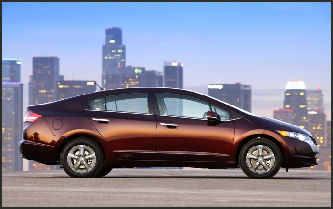
Honda Clarity fuel cell car Honda Motor Company is the world's largest motorcycle maker and engine maker and the second largest Japanese car maker in the United States. It has a reputation for being engineering-driven and a place where technological innovation is sometimes pursued for its own sake
Honda and Nissan fight it out to be Japan’s No. 2 automaker. In 2001 and 2006, Honda surpassed Nissan in auto sales to become Japan’s No. 2 automaker. In 2005, it was Japan’s third largest automaker after Toyota and Nissan.
In 2009, Honda passed Chrysler to take forth place in auto sales in the United States. In 2004, Honda was ranked by Forbes as the 49th largest company in the world. It ranked 73rd in 2007 and 68th on the same list in 2008. Honda was the 6th best brand according to a 2006 Harris poll and ranked 23rd on Fortune’s list of most admired companies in 2007. On the J.D. Powers quality ranking in 2006 is was sixth behind Porsche, Lexus, Hyundai, Toyota and Jaguar.
In June 2011, Bloomberg reported, Honda performed well in J.D. Power & Associates’ Initial Quality Study,which measures consumer complaints in the first 90 days of vehicle ownership. Honda Motor Co. replaced Ford as the top mass-market brand in this year’s study, jumping to second place from sixth last year. Honda’s highest ranking ever was helped by having seven models rated best in their vehicle categories, J.D. Power said. The previous highest ranking for Tokyo-based Honda was third in 1997. “Honda benefited from having mostly vehicles that carried over from the previous model year and there were no big new- model launches,” David Sargent, J.D. Power’s vice president for global vehicle research, said. “It’s unusual for any brand to win seven awards, but they’ve just done a lot of hard work.” [Source: Bloomberg, June 27, 2011]
Honda placed 19th in the 2011 Interbrand Best Global Brands ranking. Coca Cola and IBM were No. 1 and 2. In February 2010, Honda and Subaru were named the best all-around vehicle makers by Consumer Reports. It was the forth year in a row that Honda topped the ranking. The ratings are based on the magazine’s average road test scores and predicted reliability scores. In 2010, Honda and Subaru both had an overall score of 77 out of 100. They were followed by Toyota and Hyundai with Nissan and Volkswagen tied for forth.
Honda is based in Tokyo and has a large operation in Utsonomiya, Japan. It has had success over the years because of its ability to produce reliable, high-quality cars and stands out from the crowd with it innovative ideas. Company executives have consistently said their goal is not to be largest company but to be the best.
Websites and Resources
Good Websites and Sources: Honda honda.com ; History of Honda world.honda.com/history ; Asimo Robot asimo.honda.com ; Hondajet hondajet.honda.com ; Honda Concept Cars automobiles.honda.com/future-cars ; Honda Racing racing.honda.com ;New York Times articles on Honda nytimes.com ; Car Connections on New Hondas thecarconnection.com/make/new,honda
Hybrids and Fuel Cell Cars: Wikipedia article on Hybrids Wikipedia ; Honda Hybrids honda.com/Hybrid ; Wikipedia article on Fuel Cells Wikipedia ; Honda Fuel Cells honda.com/FuelCell ;
Links in this Website: INDUSTRIES IN JAPAN Factsanddetails.com/Japan ; JAPANESE COMPANIES Factsanddetails.com/Japan ; TRADE AND OVERSEAS BUSINESS IN JAPAN Factsanddetails.com/Japan ; MACROECONOMICS IN JAPAN Factsanddetails.com/Japan ; JAPAN INC. AND REFORMS Factsanddetails.com/Japan ; JAPANESE AUTOMOBILE INDUSTRY Factsanddetails.com/Japan ; AUTOMOBILES AND DRIVING IN JAPAN Factsanddetails.com/Japan ; HYBRIDS, FUEL CELLS AND ELECTRIC CARS IN JAPAN Factsanddetails.com/Japan ; JAPANESE AUTOMOBILE COMPANIES Factsanddetails.com/Japan ; TOYOTA Factsanddetails.com/Japan ; TOYOTA PRODUCTION AND WORKERS Factsanddetails.com/Japan ; TOYOTA PROBLEMS Factsanddetails.com/Japan ; TOYOTA CARS, RACING AND ROBOTS Factsanddetails.com/Japan ; HONDA Factsanddetails.com/Japan ; HONDA CARS, PLANES, ROBOTS AND RACING Factsanddetails.com/Japan ; NISSAN Factsanddetails.com/Japan ;
Good Websites and Sources on Industry: Good Photos at Japan-Photo Archive japan-photo.de ; Companies Listed by Industry mizuho-sc.com ; Ministry of Economy, Trade and Industry meti.go.jp/english ; Statistical Handbook of Japan Manufacturing Chapter stat.go.jp/english/data/handbook ; 2010 Edition stat.go.jp/english/data/nenkan ; News stat.go.jp
Honda Sales and Profits
Honda made a net profit of about $6 billion in fiscal 2010-2011, a 99 percent increase from the previous year, on sales of around $150 billion. Ths strong showing was due largely to the sales recovery in North American and strong sales in emerging markets.
For fiscal year 2009-2010, Honda reported an operating profit of ¥363.73 billion , up 91.8 percent from the previous year, on sales of ¥8.58 trillion, down 14.3 percent from the previous year. The high profits were attributed to robust sales in Asia and cost-cutting efforts.
Honda’s global sales reached a record 3.76 million units in 2007, a 6 percent increase from the previous year. The company sold 3.16 million units in 2004 and 3.39 million cars in 2005. Honda did well in 2007 and 2008 in the United States while other automakers — including Toyota’suffered. Even though it markets some relatively heavy trucks and SUVs, Honda still sells a large variety of fuel-efficient vehicles that sold well while gas prices were high. In the first half of 2008, Honda sales were up 3.2 percent while sales at Chrysler declined 22.8 percent, GM declined 17.7 percent, Ford declined 14.1 percent and Toyota declined 7.6 percent
Honda profits were $1.2 billion the quarter that ended June 30, 2006. Profits rose in 2007 as a result of higher demand for compact cars overseas. The sale of the CR-V SUV and Fit compacts were robust n the United States. Sales increased in China and India.
In 2000, Honda has worldwide market share of 3.8 percent (compared to 16.4 for General Motors and 7.5 percent for DaimlerChrysler) and an American market share of 8.1 percent (2003, compared to 28.4 for General Motors and 17 percent for DaimlerChrysler). 1999
Soichiro Honda
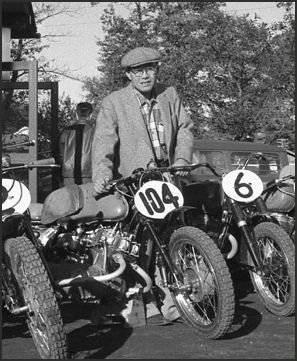
Soichiro Honda Soichiro Honda, the founder of Honda Motor Co,. was the first Japanese to be inducted into the U.S. Automotive Hall of Fame. He once described himself as a “hands person.” His hands were covered with scars from hammers, cutters and other tools he used to make his creations.
Honda was known in the company as “Dad.” He had a nasty temper and was notorious for scolding his employees. He was equally proud of his ability to converse with geisha and a number of subjects.
Honda died in 1991. He liked to jot down his thoughts. Some of them have been collected in a book called “Watashi no Te ga Kataru” (“My Hands Speak”).
Honda’s grandson, also named Soichiro Honda, was president of a research car manufacturer closely linked to Honda Motor Company. He was arrested in 2003 on charges of concealing ¥2.8 billion in income and evading ¥1 billion in taxes.
Early History and Honda Motorcycles
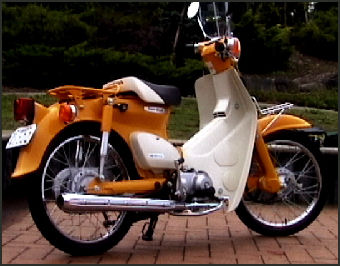
2004 version of the Super Cub Honda first made a name for itself in motorcycles. It began producing motorcycles in 1949 with the launch of the Dream D type motorcycle equipped with a 98cc two-stroke engine. Honda also produced the Cub F-type auxiliary engine, which was mounted on the real wheel of bicycles and helped spread the use of motorized two-wheeled vehicles.
In 1956, Honda and his partner Take Fujisawa traveled to Europe to search for markets and found one for a small motorcycle that was bigger and more powerful than the widely available motorscooters but smaller than a large motorcycles.
The result was the Honda 50 Super Cub. Fujisawa was so confident of its success that he set up the world's largest motorcycle plant at the time to make 30,000 of them a month in the town of Suzuka.
The Honda Super Cub debuted in 1958 with a 49cc engine, By 1960, Honda was exporting 165,000 motorcycles a month. Today, more than 60 million Cubs have been sold worldwide.
Under the slogan of “building products close to the customer” Honda entered the overseas production in 1963 with the opening of its first offshore plant in Belgium. It now has 32 factories in 22 countries.
Honda Makes Cars
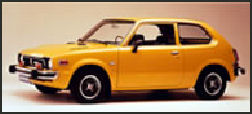
1974 Civic In 1972, Honda engineer Takeo Fukui, designed the efficient CVCC engine which met the emission standards of the 1970 Clean Air Act without an expensive catalytic convertor and made Honda the brand of choice among early environmentalists.
Honda’s focus on fuel efficiency and the environment dates back to the clean air legislation and energy crisis of 1960s and 70s when Honda adopted the motto, “Blue skies for our children.” After the 1973 oil crisis the Honda Civic — which boated the best gas mileage of any car — captured a large chunk of the American small car market. Later the Accord became popular among those who wanted something a little larger and jazzier than a compact but still was small and fuel efficient.
The Accord was introduced as a hatch back in 1976 and immediately drew raves for reliability and good gas mileage. It has consistently been one of the highest rated and best selling cars in the United States. In the late 1980s it became the best-selling car in the United States. Honda sold 400,000 units a year and made large profits from the car. In 2003, Accords sold for between $15,000 and $25,000.
The Accord and Toyota’s Camry battled each other over the title of America’s top selling car. Accord dominated the late 1980s and early 1990s. Camry took over in the late 1990s. In 2002, the Accord topped Camry as America’s top car. The Camry and Accord are the two most popular cars among American car thieves. Crime experts say that Hondas are among the easiest cars to break into.
Acura — Honda’s luxury car brand — was set up in the United States in the 1980s before Toyota’s Lexus and Nissan’s Infiniti, but over the years lost market share to them.
Honda Success
Honda has done consistently well over the years with its reputation for making small, well-built fuel-efficient cars. Honda has posted the highest corporate average fuel economy of any automaker for its overall fleet every year from 1993 to 2008.
Honda earned record profits in the early 2000s with a string of successful compact cars and minivans. In 2001, Honda sold a record 860,000 vehicles in Japan and earned $3 billion in profits.
In 2003 sales declined. In Japan, it was unprepared when minivans suddenly became all the rage in Japan. In the United States, the Accord and Civic faced increased competition. In 2004 earnings in the United States declined as a result of poor dollar-yen exchange rates and declines of sales of the Civic and Accord. This was offset by healthy sales of the Odyssey minivan and strong sales of motorcycles worldwide and strong sales of automobiles in Asia, particularly China.
Honda and the Economic Crisis in 2008 and 2009
Honda fared much better than other car makers during the global financial crisis in 2008 and 2009. It had an $1.37 billion profit in fiscal 2008 while Toyota record a $4.61 billion loss.
But that doesn’t mean that Honda didn’t have to make some adjustments. In May 2009, Honda shut down six factories in the North America for 13 days to cut production by 62,000 cars and reduced pay to for office and factory workers and offered early retirement incentives.
In February 2009,Takanobu Ito, a 55-year-old expert on auto development with experience in the United States, was named the new president of Honda, in an apparent effort to bring in younger, fresher management.
By March 2009 sales were beginning pick up significantly. Honda increased its production by 62 percent. Honda made a $3.5 billion profit for fiscal of 2009. It posted a $750 million profit in the second quarter of 2009.
Honda Versus Toyota

new Honda vehicle
launched in 2009 Honda has a reputation for having the best engineers while Toyota is know for having more skilled marketers, Bryan Wallach of Newsweek wrote, “Honda can sometimes outthink itself, creating cars that are more appealing in the design lab than on the dealer’s lot, like the clunky Insight.” A Honda executive told Newsweek, “Toyota may have engineers that aren’t as smart as Honda’s, but they’re certainly better at listening to consumers.”
One automobile industry analyst told the New York Times. “Honda’s car seem to have more personality than Toyota’s. Their cars are enjoyable to drive not just appliances.” A woman who traded in her Toyota Corolla for a Honda Fit said, she picked the Fit because it “stood out.” “People I know think the car is cute and it surprises them with its pep, people are also surprised at the amount of interior space.”
Honda Management
High-levels executives at Honda work in a large room with other office workers rather than in separate offices. This lends itself to incremental change rather than bold moves.
Hirouki Yoshino was the CEO and president of Honda from 1998 to 2003. Born in war-torn Manchuria and a survivor of the Great Fukui Earthquake, he joined the research department of Honda after graduating Tokyo’s School of Engineering. He was involved in research to reduce the pollution produced by cars and headed factories in the United States and Japan. He likes astronomy and car racing.
Take Fukui was the CEO and president of Honda from 2003 to 2009. He was involved the sports racing arm of Honda which won the 1985 world motorcycle championship in the 250cc and 500cc class with a single rider, something previously thought impossible. Fukui often test rode vehicles himself.
Honda and Toyota send new college-educated employees to work on assembly lines for several months after they are hired.
Honda Productivity

Honda’s 2010 production capacity: 4.43 million vehicles. Honda builds a wide variety if vehicles from subcompacts to SUV to minivans to luxury cars from a few basic chassis designs. This efficiency has been a key to their productivity and profits. Factories are flexible and able to make different kinds of cars depending on demand. The Honda plant in East Liberty Ohio, for example, can just as easily make CR-Vs as it can Civics.
According to the Economist: “Honda has a network of factories around the world, all hooked into the same supply chain. Each operates in the same way, so each is able to make any vehicle in the product range according to demand. This give the company tremendous flexibility, thanks as much to slick logistics as to excellence in manufacturing.”
“Honda pays meticulous attention to detail to help ensure that its products are made on time. It has special data system in each of its factories to monitor weather forecasts. These allow factory managers to talk in advance about bad weather and how it might affect deliveries. They can decide what and when to stock up.”
Honda workers need 2.46 days to make a vehicle in factory in the United States, compared to 2.52 for Nissan, 2.73 for Toyota, 2.97 for Ford, 3.04 for General Motors and 3.20 for Daimler-Chrysler. New managers and office staff are put on the assembly line in first months of work to get a sense of what that kind of work is like.
In 2005, Honda was named North America’s 3rd most efficient manufacturing operation after Toyota and Nissan by the closely-watched Harbour Report. It takes the company 32.02 hours to produce the average car or truck. By contrast GM, Ford and Chrysler take between 34 and 37 hours to make a vehicle and Toyota and Nissan take between 28 and 30 hours. .
Honda and Safety

side, head-level air bags In recent years, Honda has put emphasis on safety. In 2001, it opened the world’s most advanced test crash facility in Utsonomiya in a building the size of a dozen football fields.
Ken Belson wrote in the New York Times: “In white jump suits and green baseball caps, the 10-man clean-up crew arrives seconds after a tiny lime green Fit and mid-size four-door Leng smash into each other at 50 kilometers (30 miles) an hour. Hubcaps are retrieved, broken glass swept up, and computers are plugged into the car’s data boxes.”
A new Honda safety facility in Raymond, Ohio has a cannon that fires crash-test dummy heads at cars to check about pedestrian injuries.
Honda is a leader in making small cars safe by outfitting them with advanced safety equipment as a standard feature. It has done so in part to make small cars safer in collisions with large cars and SUVs. A Honda researcher told the New York Times, “We are determined to say that large vehicles and small vehicles can coexist on the road....We do not agree with people who say you can only have safety in an expensive car or a big car.”
In the near future Honda hopes to make air bags and anti-lock brakes standard in all cars. It plans to introduce side airbags and airbags that come down from the roof to protect the heads of occupants. SUVS and light trucks will have stability technology to prevent them from rolling over.
Among the safety features found in Honda cars are small triangle in the front windshield — on the left and right, slightly above the driver’s line of sight — which makes it easier for drivers to avoid accidental contact in tight situations such as passing another car or turning into a narrow alleyway. Experiments by Honda showed that the triangles unconsciously encouraged drivers to stabilize their line of sight when making a left hand turn by give the driver a better sense of the vehicles width.
Honda Business
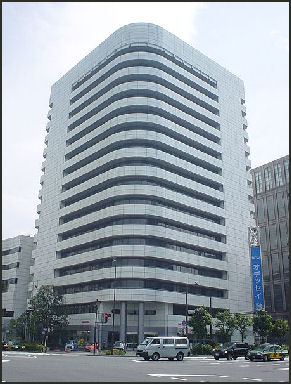
headquarters in Tokyo In its 46 year history Honda has never reported a loss. Nissan and Honda have higher profit margins than Toyota. Honda was one of the few automakers to avoid losses from the global recession because of its focus on small models with small profit margins that continued to sell while sales of big cars plummeted. Honda posted record profits of ¥272 .4 billion in April-June quarter of 2010.
Honda is committed to remain independent and not form a partnership as has been the trend in the automobile industry. As of 1999, the only Japanese companies without major foreign investors were Toyota and Honda.
In the United States, Honda got onto the soybean processing, tofu and soy sauce producing businesses as a way to fill empty containers that brought car parts to American factories on the return journey to Japan. The scheme began in the mid 1980s and is working s well that Honda now ships soy product to Thailand and Australia.
Honda sold 472,384 cars in Japan in 2004, a 2.7 percent rise from the previous year. Honda is starting to have problems in Japan. When it introduces a new model, Toyota quickly responds and introduces a similar car. Japanese consumers complain Hondas are too plain.
Honda in the United States
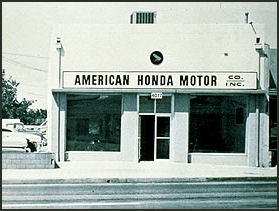
1959 Honda store In 2009, Honda passed Chrysler to take forth place in auto sales in the United States. It is still behind Toyota, GM and Ford.It had a 8.1 percent market share in 2003, up from 7.4 in 2002. It sold its 10 millionths vehicle there in November, 2003. In July 2006, Honda topped Daimler-Chrysler for the first time in monthly sales in the United States.
“With a share of 9.0 percent, Honda fell to fifth spot in sales in the United States in 2011. Kyodo reported: “Chrysler Group LLC's sales jumped 24.3 percent to 1,349,345 units for a market share of 10.6 percent as it took the No. 4 slot from Honda Motor Co., whose sales suffered a 6.8 percent drop to 1,147,285 units after posting a 6.9 percent rise in 2010. [Source: Kyodo, January 5, 2012]
The United States is Honda’s largest market. Honda sells 53 percent of its vehicles in North America. It sells about twice as many cars in the United States — about 1.5 million — as in Japan and has traditionally earned around 70 to 90 percent of profit in the United States.
Honda was the first Japanese automaker to open a plant in the United States. The plant opened in Marysville, Ohio — on a site picked by Honda founder Soichiro Honda — with 450 employees in September 1979. It initially made motorcycles and began making cars in 1982.
Honda has 63,788 workers in the United States. The heart of its operations are still in Maryville,. In 2007 plants there produced 701,317 cars and light trucks and 719,861 transmissions and 1.1 million automotive engines. There is also an SUV plant in South Carolina and a new plant in Indiana. Honda currently exports US-built vehicles to 40 countries, including all Acura exports to China and Accord sedans to the Middle East. Exports from its US and Canadian plants rose 29 percent to 47,206 vehicles in the first 11 months of 2011 despite the parts shortages.
Honda in Europe and Asia
Most of Honda's cars made for the European market are made at its plant in Swindon, England, which opened in 1992. Honda has had trouble in Europe. It reported a $444 million loss in fiscal 2000-2001. To turn things around it launched some new cars, including several with diesel engines. In 2007, Honda sold a record 376,477 cars in Europe — a 22 percent increase from the precious year — with consumers snapping up its diesel cars. Honda is now beginning to put an emphasis on marketing hybrids in Europe and expanding in the growing Russian market.
Honda began making cars in Thailand in 2003 and has a factory in Turkey.
Honda has plans to sell a very small car in Europe and emerging countries such as China and India in the early 2010s. The engine displacement of the four or five seat car will be less than 1 liter, smaller than the 1.3 liter engines on the Fit subcompact series,
Big Honda Motorcycles to Be Made in Thailand
November 2011 the Yomiuri Shimbun reported: “Honda Motor Co. has decided to partially shift production of large and midsize motorcycles with engine capacities of 400cc or more, which have been produced only in Japan, to Thailand. Honda has consistently produced high quality large and midsize motorcycles in Japan. However, their profitability has dropped sharply due to the current appreciation of the yen. [Source: Yomiuri Shimbun, November 29, 2011]
“Honda has decided it must lower production costs by producing some of these models overseas. The company plans to produce newly developed 400cc to 500cc models as early as October 2012 at a factory in a Bangkok suburb.With a shrinking domestic market, Honda has been trying to improve profitability by shifting production from its Hamamatsu factory in Shizuoka Prefecture to its Kumamoto factory and consolidating production in 2008. The company has also increased overseas parts procurement.
“The company has been producing 250cc-or-smaller models, a category of bikes with fierce price competition, overseas, including in China, while large and midsize models have been made in Kumamoto and exported to developed countries in the West. Honda plans to continue production at its Kumamoto factory and keep the current employees. The Thai factory will become the company's new base for exports, responding to increased overseas demand.
“Honda's motorcycle facility in the suburb of Bangkok suffered no damage from the Thai flooding in the autumn of 2011. It resumed production in November when parts supply chains were restored. Thailand has positively taken part in free trade agreements and Honda's move shows the importance of Thailand as a production base even after the company suffered flood damage.
Honda in China
Honda was the first Japanese company to manufacture cars in China and is said to be the most profitable car company in China. It has a 50-50 partnership with Guangzhou Automobile Group, which it paid $100 million to obtain. The joint-venture is known as Guangzhou Honda.
Honda entered the market in China relatively late, but made up quickly for lost time and quickly became a major player there. In the first three months of 2005 Honda was the No. 2 car seller in China behind Hyundai. It sold 45,000 cars, a 58 percent increase from a year earlier. Honda sold 117,130 vehicles in 2003, making it the fifth largest automaker in China, with a 6 percent share. Sales grew by 31 percent in 2007.
In 2004, Guangzhou Honda made and sold more than 200,000 vehicles, nearly double what they sold in 2003, In 2001 they sold to 50,000 vehicles. In 1999 they sold 30,000 vehicles.
Honda has made an effort to work with its Chinese host rather than simply manage them and use them as a platform for its operations. Of the senior management team, two are Japanese and two are Chinese. The Chinese workers earn $240 a month, a good salary in China. Honda uses 110 Chinese suppliers, many on the Guangzhou area, and used local suppliers for 40 percent of its parts right from the start.
Honda has two ventures in China: with Guangzhou Automobile Group and . Hong Kong-based Denway Motors. It has been marketings it cars the Western way through dealerships. As of 2004, it had dealerships in every province of China except for Tibet.
Honda Production in China
Honda makes the Accord sedans, Odyssey minivans, CR-V vehicles, and Fit compact cars. In 2005 it began producing a small hatchback called the Jazz for export to Europe.
Honda obtained an engine plant in Guangzhou — formally used by Peugeot — through it partnership with Guangzhou Automobile Group. It poured $100 million into the plant. Production of Accords there began in March 1999. The factory now has a capacity of 270,000 vehicles. The plan has been export 50,000 cars made at the plant and sell the rest to Chinese markets. In 2006 123,000 Accords were produced at the plant
In 2006, opened a second plant in Zengcheng, Guangzhou. The plant will cost $266 million and has a capacity of 120,000 vehicles a year, raising Honda’s capacity to 360,000. It produces Accords, Odyssey vans and Cuty and Fit subcompacts,
See China
Honda’s Strategy to Deal with the High Yen
Mira Oberman of AFP wrote: “Honda will further boost exports of US-built vehicles and expand its overseas production in order to hedge against an "abnormally high" yen, the Japanese automaker's chief said. The Japanese automaker aims to increase local production to about 70-80 percent of the vehicles it sells in each region while importing the rest from various plants around the world, Honda chief executive Takanobu Ito said. [Source: Mira Oberman, AFP, January 9, 2012]
"That's the way we can grow, and that will be the ultimate method to hedge against these kind of currency ups and downs..."In the US, for example, we have already achieved 87 percent of local North American production, which satisfies me," Ito said through a translator. "What I'm asking North America or the US to do is to contribute to other regions such as the Mideast by providing North American production to those regions.”
Honda Bounce Back After the March 2011 Earthquake and Tsunami
Nick Bunkley wrote in the New York Times: “Honda was hard hit by the March 2011 earthquake and tsunami “because it has two major plants on the edge of the quake zone, and many of its suppliers sustained damage or had to evacuate because of radiation concerns. The company delayed the introduction of a revamped CR-V crossover vehicle, and it struggled to build enough of its redesigned Civic compact because dealers already had sold most inventory of the outgoing version. [Source: Nick Bunkley, New York Times, October 13, 2011]
“John Mendel, executive vice president of American Honda, said inventories hit their low point in August 2011 and now were increasing steadily. The backlog of demand means replenishing dealerships is like “trying to fill a bathtub with the stopper open,” with many cars being snatched up as soon as they arrive, he said.”I think people will be back in Honda showrooms in a big way, and I hope the competition has enjoyed our brief respite in terms of inventory,” Mr. Mendel said. “I look forward to seeing them back on the battlefield again soon.”
“To keep shoppers from wandering onto a competitors’ lot and giving rival dealers more confidence, Honda introduced a program called the “Honda Promise,” which allows buyers to lock in a discount on vehicles that are unavailable. Automakers usually offer rebates or special financing on cars and trucks in stock, and the deals generally expire at month’s end. “It’s a great idea and a great program,” said Jason Heard, the general sales manager at Frank Ancona Honda in Olathe, Kan., where September inventories were about two-thirds of normal levels. “Honda’s done a great job at getting us built back up, but dealers always want more cars.”
Image Sources: Honda except headquarters and motorcycles (Honda via Wikipedia)
Text Sources: New York Times, Washington Post, Los Angeles Times, Daily Yomiuri, Times of London, Japan National Tourist Organization (JNTO), National Geographic, The New Yorker, Time, Newsweek, Reuters, AP, Lonely Planet Guides, Compton’s Encyclopedia and various books and other publications.
Last updated October 2012
